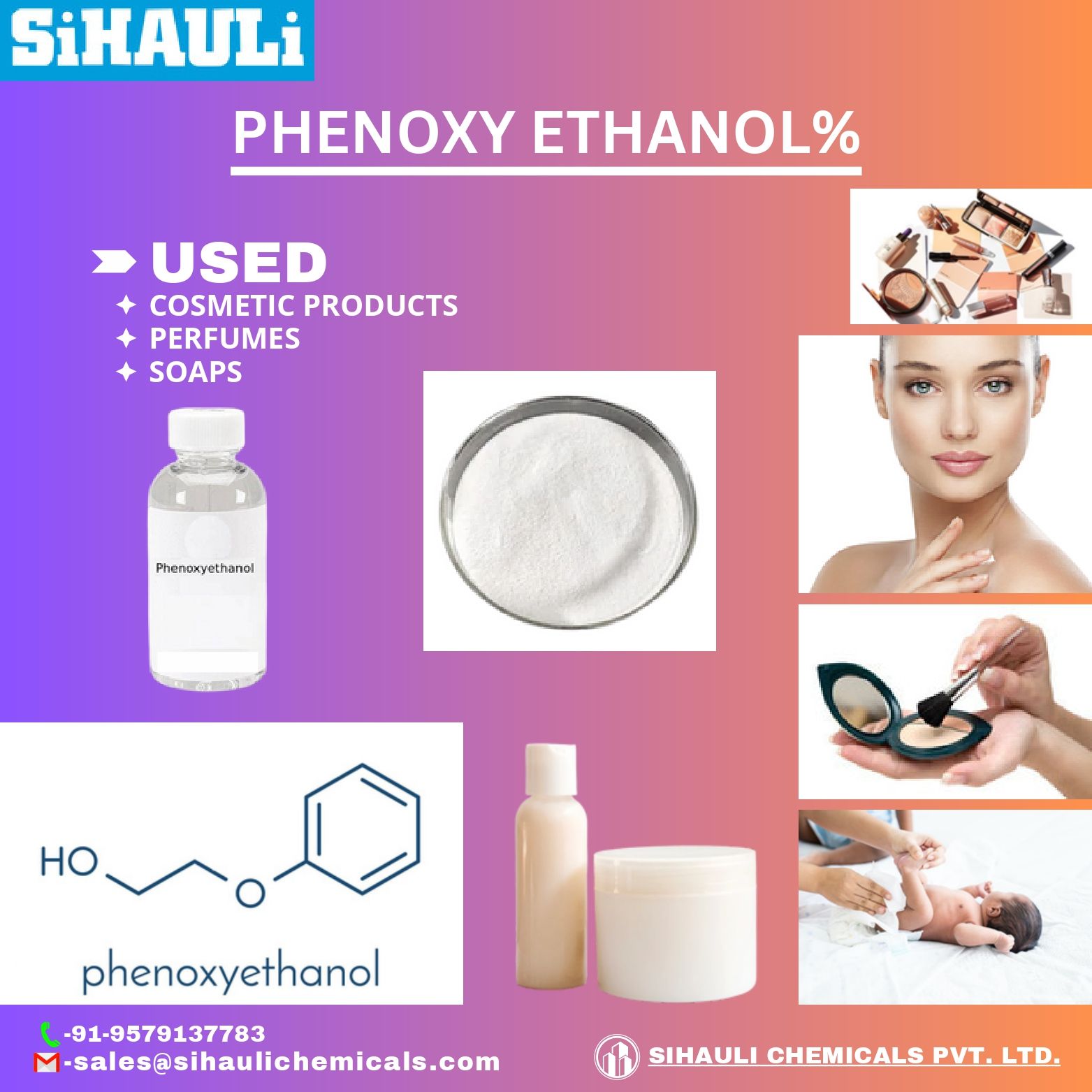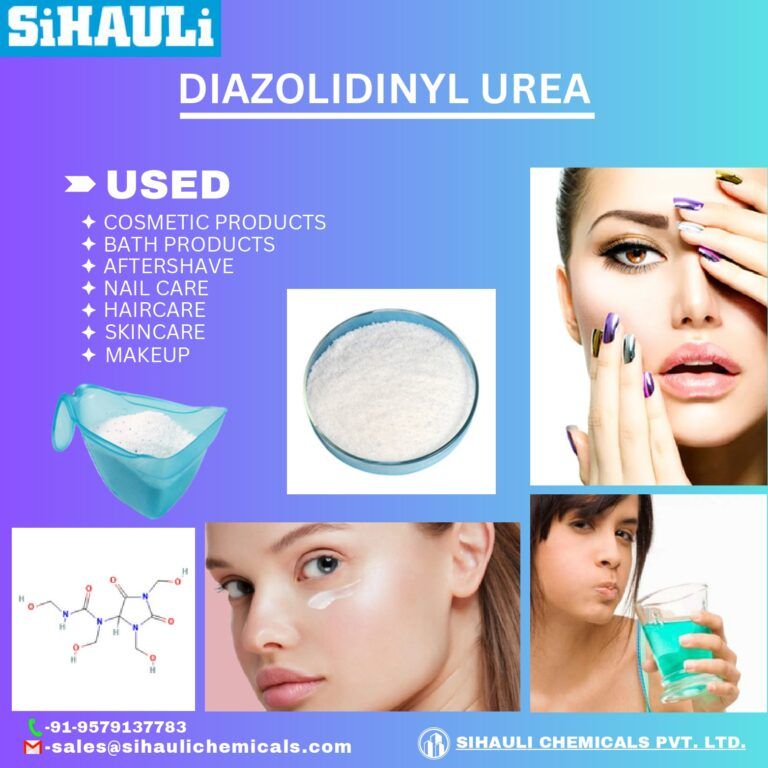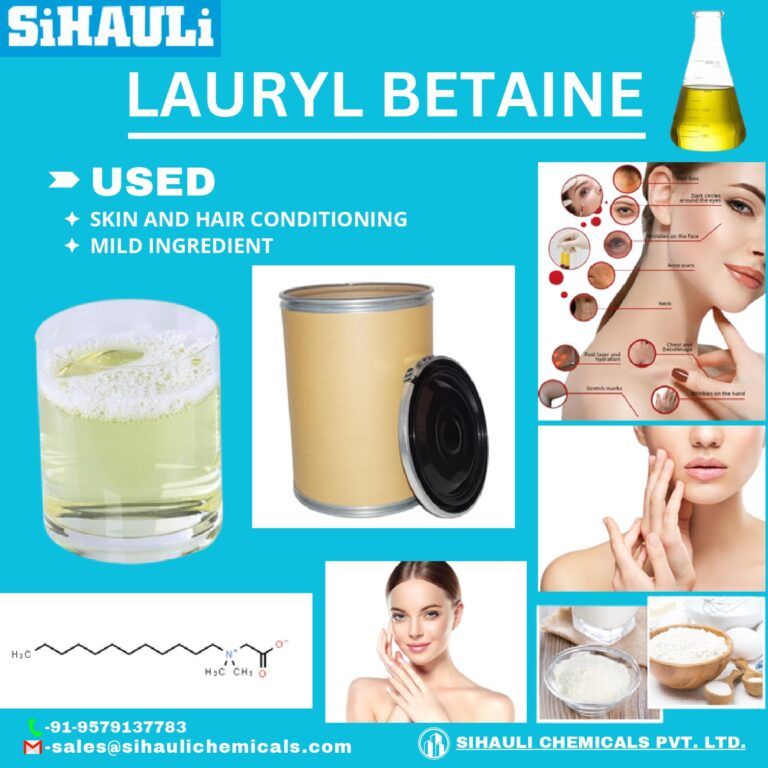Phenoxyethanol is an antiseptic used as a hand disinfectant or preservative in medications. Phenoxyethanol is a colorless liquid with a pleasant odor. It is a glycol ether used as a perfume fixative, insect repellent, antiseptic, solvent, preservative, and also as an anesthetic in fish aquaculture.
Phenoxyethanol is ethylene glycol monophenyl ether, and can be described as a glycol phenyl ether, and aromatic alcohol. It is a synthetic chemical substance obtained by reacting phenol with ethylene oxide in an alkaline medium. Phenoxyethanol occurs as a colourless, slightly viscous liquid with a faintly pleasant odour.
Pharmacopoeial Compliance: USP-NF; Ph.Eur; B.P; J.P; I.P
Synonyms and Trade Names: Phenoxyethanol; Ethyleneglycol Monopthenyl Ether; 1-Hydroxy-2-Phenoxyethane; Phenyl Collosolve; 2-Phenoxyethanol; Phenyl Ether; 2-PE; Dowanol® EPh; Emeressence® 1160; Phenoxen; Phenoxetol
Uses and Applications: Antimicrobial Preservative
Description
Phenoxyethanol (preferred IUPAC name: 2-Phenoxyethanol-1-ol; chemical formula C8H10O2) is a glycol phenyl ether and an aromatic alcohol, which can also be described as ethylene glycol monophenyl ether. It is found to occur naturally in a few plants (e.g tea and chicory) and exhibits germistatic and germicidal properties hence it common use as a preservative in pharmaceutical and cosmetic formulations, as well as in vaccines. Phenoxyethanol is also used as a fixative (to reduce the volatility of essences and prolong aroma) in perfumes.
The antimicrobial effects of Phenoxyethanol are currently thought to be mediated via the following mechanisms:
uncoupling of oxidative phosphorylation
increase of permeability of the bacterial cell membrane to potassium ions
inhibition of biosynthesis of macromolecules (RNA & DNA)
Although naturally occurring, industrial-grade Phenoxyethanol is produced by reacting phenol and ethylene oxide at a high temperature and pressure. The obtained intermediate is neutralised and purified to reduce levels of impurities (phenol and ethylene oxide). It is supplied as an oily, slightly viscous, colourless or off-white liquid, with a faintly perceptible aromatic essence.
Chemical Structure & Identifiers
Chemical Name 2-Phenoxyethanol
CAS Registration Number [122-99-6]
Empirical Formula and C8H10O2
Molecular weight 138.16
EC Number 204-589-7
UNII Code (FDA) HIE492ZZ3T
Regulatory Status
Phenoxyethanol is an approved excipient and is currently listed in the USP, PhEur and JP. It is also included in the FDA Inactive Ingredients Database (topical preparations). Phenoxyethanol is also approved for use in cosmetics and topical medical devices. It is not approved for addition to food products.
Physicochemical Properties
Form Liquid
Appearance olorless, clear, oily liquid
pH pH 6.0 (1% v/v aqueous solution)
Antimicrobial activity Phenoxyethanol exhibits broad spectrum antimicrobial activity against bacteria, yeasts, and molds
Autoignition temperature 500 oC
Relative density 1.1094
Vapour pressure 0.007 mm Hg (25 oC)
Viscosity 20.5 cSt (25 oC)
Boiling point 245.2 oC
Dissociation constant pKa= 15.1
Flash point (open cup) 127 oC
Log P (calculated) 1.16
Surface tension 42.0 dynes/cm
Heat of combustion 958 kcal/mol
Melting point 14 oC
Partition coefficients Octanol:water = 1.16
lsopropyl palmitate water = 2.9
Mineral oil: water = 0.3
Refractive index 1.534 (20 oC)
Solubility Soluble in ethanol, glycerin and propylene glycol. Sparingly soluble in water (2.7%); Isopropyl palmitate (4%) and Mineral oil (0.7%)
Pharmacopeoeal Specifications
USP-NF Ph.Eur
Official name Phenoxyethanol Phenoxyethanol
Authorised use Excipient Excipient
Definition specified specified
Identification specified specified
Characters n/a specified
Refractive index n/a 1.537 – 1.539
Relative density 1.105 – 1.110 1.105 – 1.110
Chromatographic purity specified n/a
Related substances n/a specified
Assay 98.0 – 102.0% 99.0 – 100.5%
Labelling n/a n/a
Key: n/a Specification is not listed
*All claims with respect to conformity are subject to our Terms and Conditions. No express or implied warranty is made for specific properties or fitness for any particular application or purpose.
Applications in Pharmaceutical Formulations or Technology
Phenoxyethanol is an antimicrobial preservative and disinfectant. has been used widely as a preservative in cosmetic products for decades and is currently used in topical pharmaceutical products, as well as topical medical devices and vaccines. The typical concentrations at which it is used are 0.5-1.0%.
Phenoxyethanol has a wide spectrum of antimicrobial activity and is effective against various Gram-negative and Gram-positive bacteria, as well as against yeasts. However, it has only a weak inhibitory effect on resident skin flora when compared with other common preservatives (e.g. Methylisothiazolinone, Ethylhexylglycerin and Methylparaben). For this reason, it is frequently used in combination with other preservatives.
Phenoxyethanol is also used therapeutically. A 2.2% solution (or 2.0% cream) has been marketed as a disinfectant for superficial wounds, burns, and minor infections of the skin as well as mucous membranes.
Safety and Precautions
Phenoxyethanol is considered one of the most well-tolerated preservatives used in cosmetic products. According to the European Scientific Committee on Consumer Safety, Phenoxyethanol is safe for all ages – including children of all ages – when used as a preservative in topical products at a maximum concentration of 1%. Adverse systemic effects have been observed in toxicological studies on animals but only when the levels of exposure were many magnitudes higher than those to which consumers are typically exposed when using Phenoxyethanol-containing products. The French National Agency for the Safety of Medicines and Health Products (ANSM) recommends that Phenoxyethanol is avoided as a preservative in leave-on products intended for application on the nappy area (including wipes) of children aged <3 years.
Toxicology: LD50 (rat, oral): 1.26 g/kg
Stability and Storage Conditions
Phenoxyethanol is a chemically stable chemical substance. The assigned shelf-life is 24-36 months. The bulk material should be stored in a well-dosed container in a cool, dry place. Aqueous phenoxyethanol solutions are stable and may be sterilized by autoclaving.
The antimicrobial activity of Phenoxyethanol are susceptible to the presence of nonionic surfactants. Activity against some organisms (e.g Pseudomonas aeruginosa) are reportedly reduced in the presence of cellulose derivatives (Methylcellulose, Sodium carboxymethylcellulose, and Hypromellose).
When processing Phenoxyethanol, observe applicable SHEQ precautions appropriate to the circumstances and quantity of material handled. Phenoxyethanol may be irritant to the skin and eyes, therefore suitable PPE (eye protection and gloves) is recommended.



